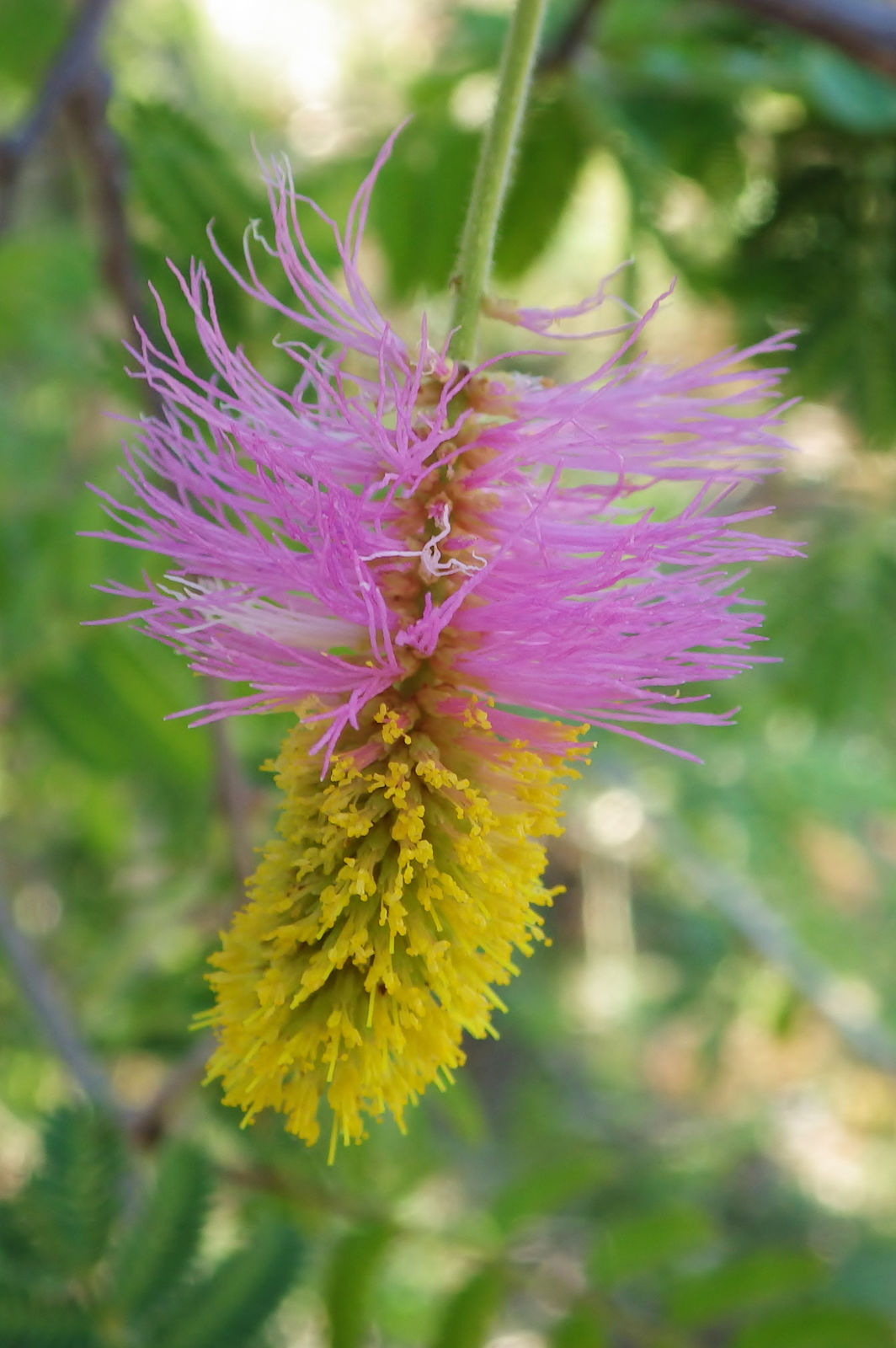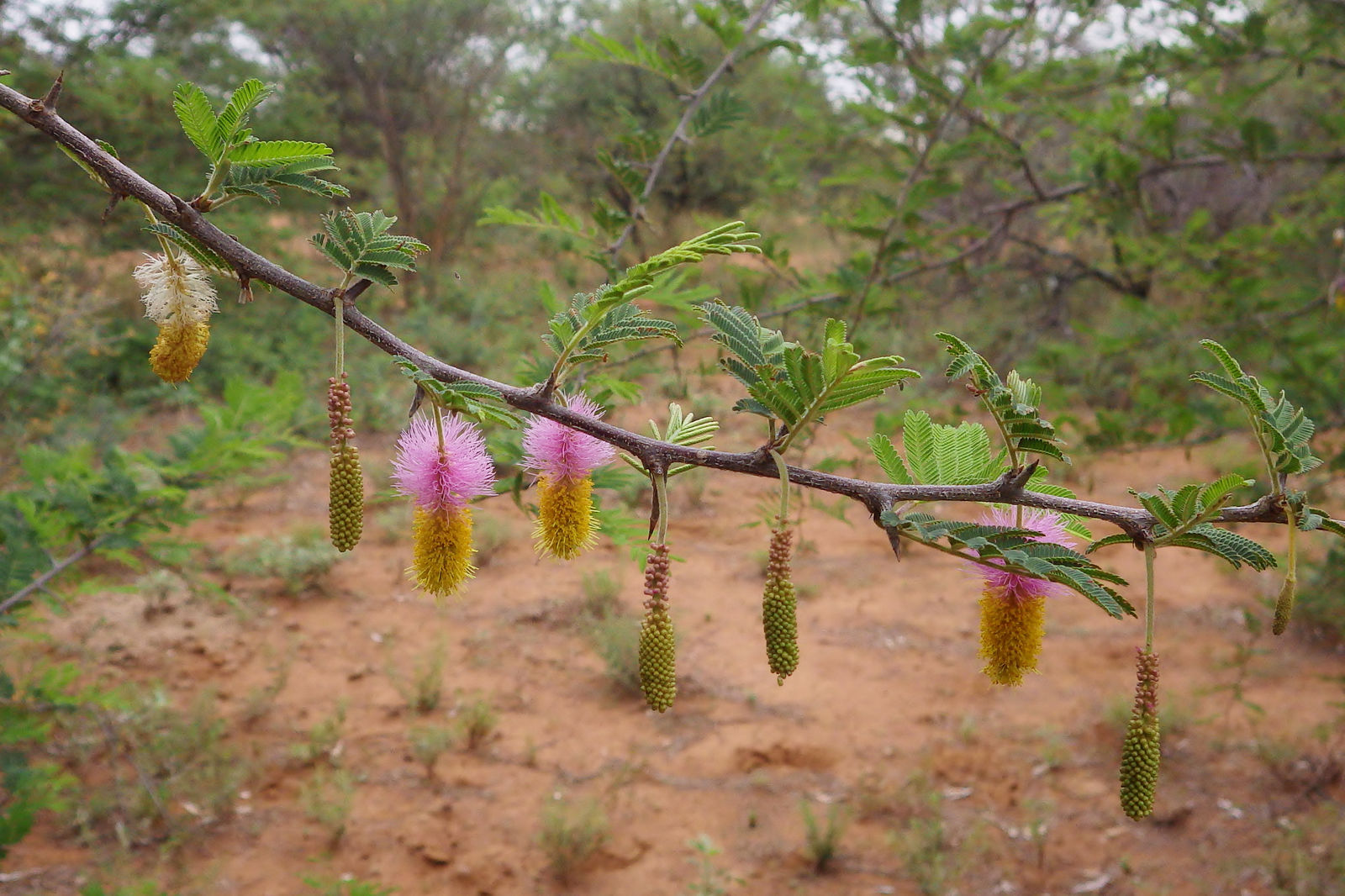Sickle Bush
dichrostachys cinerea
Also known as: ["Sickle Bush","Mimosa Sicklebush","Kalahari Tea"]
Overview
A deciduous shrub or small tree native to Africa, known for its distinctive bipinnate leaves and showy, bicolored flower spikes resembling a sickle.
Benefits & Perks
["drought tolerant","wildlife attractant (bees, butterflies, birds)","aesthetic foliage"]
Botanical Classification
| Phylum: | Magnoliophyta |
| Class: | Magnoliopsida |
| Order: | Fabales |
| Family: | Fabaceae |
| Genus: | Dichrostachys |
| Botanical Name: | Dichrostachys cinerea |
Plant Characteristics
Basic Information
- Category: Shrubs
- Suitable Location: outdoor garden in arid or semi-arid regions
- Suitable For:
- Is Weed: No
- Allergenicity: low
Environmental Needs
- Climate: {"temperatureRange":"10–40°C"}
- Hardiness: {"zones":"9–11"}
- Misting: rarely required
- Drainage: Fast-draining to prevent waterlogging.
- Soil Type: Well-draining, sandy loam with some organic matter; cactus or succulent mix is ideal.
Maintenance Level
- Maintenance Level: moderate
- Toughness Level: high
- Pruning Frequency: Annually in late winter or early spring before new growth begins.
- Pruning Intensity: Moderate; remove up to one-third of old growth to rejuvenate the plant.
Care Details
Ideal Sunlight Coverage:
Full sun (6–8 hours of direct sunlight daily); tolerates partial shade but may become leggy with insufficient light.
Sunlight Tolerance Tips:
Acclimate new plants to direct sun gradually over 1–2 weeks; protect from intense midday sun in hot climates; ensure good air circulation to prevent fungal issues.
Care Requirements
Care Difficulty
moderatemoderate
Sunlight
full sun
Rotate plant weekly for even growth; use sheer curtains to filter intense sun indoors; avoid placing near large windows with direct afternoon sun.
Watering
every 7–14 days, allowing soil to dry between waterings
Water thoroughly until runoff, then allow soil to dry out; avoid frequent shallow watering; adjust frequency based on season and weather.
Soil
well-draining, sandy or loamy soil
pH: Slightly acidic to neutral (pH 6.0–7.0).
Use a mix with good aeration; avoid heavy clay soils; ensure pots have drainage holes.
Temperature
Thrives in warm conditions (20–35°C); tolerates mild frosts but prefers temperatures above 10°C; growth slows in cooler conditions.
Protect from frost; ensure good air circulation in hot weather; adjust watering based on temperature fluctuations.
Fertilizing
every 2–3 months during active growth
Fertilize only during active growth; flush soil occasionally to prevent salt buildup; use a balanced NPK ratio.
Propagation
Methods
Stem cuttings or seeds; stem cuttings are more common for home growers.
Step-by-Step Propagation Guide
- Take a 4–6 inch cutting.
- Remove lower leaves.
- Dip in rooting hormone.
- Plant in moist medium.
- Maintain humidity.
Best Time: Spring or early summer when the plant is actively growing.
Environment
Warm (20–25°C), humid, and bright but indirect light; protect from direct sun.
Medium
Well-draining mix of perlite and peat moss or cactus mix.
Hormone
Rooting hormone is recommended to improve success rates.
Timeline
Roots may develop in 4–8 weeks; establishment can take several months.
Tools Needed
Pruning shears, rooting hormone, small pots, well-draining medium.
Quick Tips
Use healthy, non-flowering stems; maintain consistent moisture; avoid disturbing cuttings during rooting.
Pruning & Repotting
Pruning Guide
Method
Selective thinning of branches; heading back to encourage denser growth.
Pruning Plan
Prune to maintain shape, encourage bushier growth, and remove dead or overgrown branches.
Tools
Pruning shears, loppers (for larger branches), gloves.
Checklist
Sterilize tools; prune during dormancy; make clean cuts; remove dead or diseased wood.
Repotting Guide
Best Season
Early spring before active growth starts.
Pot Size
One size larger pot (e.g., +2–3 cm in diameter); ensure good drainage.
Method
Remove plant gently; trim any circling roots; place in a slightly larger pot with fresh, well-draining soil.
Suggestions
Repot every 2–3 years or when roots fill the pot; beneficial for root health and growth.
Checklist
Check root bound status; prepare new pot with drainage holes; use fresh soil mix; water lightly after repotting.
Advanced Care Tips
Watering Mastery
Watering Checklist
Check soil moisture before watering; water deeply; ensure proper drainage; adjust frequency seasonally.
How to Apply Water Properly
Water directly at the root zone, ensuring even saturation; water early in the morning or late in the evening to minimize evaporation; ensure excess water drains away to prevent root rot.
Watering Schedule Tips
Water deeply once every 7–10 days during active growth in spring and summer; reduce frequency to every 3–4 weeks in fall and winter, allowing soil to dry completely between waterings.
Soil Improvement
Add perlite or coarse sand to improve drainage; incorporate compost for fertility; ensure soil is loose and airy.
Temperature Stress Management
Signs of Temperature Issues
Chlorosis or leaf drop in cold stress; wilting or scorching in excessive heat.
Cold Stress
Growth slows or halts; leaves may turn yellow or drop; prolonged cold can damage roots and lead to dieback.
Solution: Move to a warmer location; provide frost protection in cold climates; reduce watering during cold periods.
Hot Stress
Leaves may scorch, wilt, or drop; growth may become stunted; soil may dry out too quickly.
Solution: Provide partial shade during peak heat; increase watering frequency; use mulch to retain soil moisture.
Fertilizing Guide
Fertilizing Checklist
Check growth phase before fertilizing; dilute fertilizer correctly; avoid over-fertilization; stop in winter.
Fertilizing Method
Use a balanced, water-soluble fertilizer diluted to half strength every 4–6 weeks during spring and summer; avoid fertilizing in fall and winter.
Common Problems & Solutions
Toxicity Warning
Cats
Slightly ToxicCats are susceptible to mild toxicity from Dichrostachys cinerea if they consume the seeds or roots. The plant contains compounds that can disrupt normal digestive and neurological functions, leading to discomfort and potential health issues.
⚠️ Symptoms:
🌿 Toxic Parts:
⚡ Toxic If:
if eaten
Dogs
Slightly ToxicIn dogs, ingestion of Dichrostachys cinerea seeds and roots can lead to mild gastrointestinal upset and potential neurological disturbances. The toxic compounds may cause discomfort and require veterinary attention if symptoms persist.
⚠️ Symptoms:
🌿 Toxic Parts:
⚡ Toxic If:
if eaten
Humans
Slightly ToxicDichrostachys cinerea contains compounds that can cause mild gastrointestinal distress and potential neurological effects if ingested in significant quantities. The seeds and roots are the primary toxic parts, containing alkaloids and other bioactive compounds that may interfere with normal physiological processes.
⚠️ Symptoms:
🌿 Toxic Parts:
⚡ Toxic If:
if eaten
Frequently Asked Questions
Q: Is Dichrostachys cinerea suitable for dry climates?
A: Yes, it is highly drought-tolerant and thrives in arid conditions.
Q: Does the Sickle Bush attract wildlife?
A: Yes, it is known to attract bees, butterflies, and birds due to its nectar-rich flowers.
Q: Can Dichrostachys cinerea be used for medicinal purposes?
A: Traditional uses include tea made from its leaves for medicinal purposes, though scientific validation is limited.
Quick Reference
| Family: | Fabaceae |
| Care: | moderate |
| Light: | full sun |
| Water: | every 7–14 days, allowing so |
Get Expert Care Tips
Download the Plantious app for personalized care reminders and plant identification!
Google Play App Store








